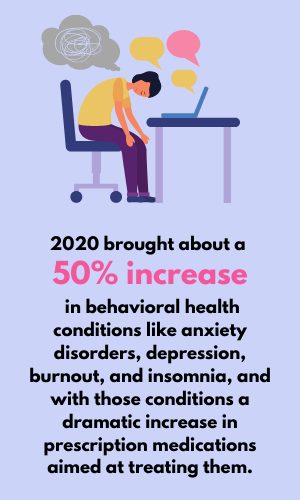Employers need to lead on the mental health crisis or business will suffer

In 2020 we had a perfect storm of stress. We witnessed demonstrations and civil unrest, economic uncertainty, unprecedented levels of unemployment, election year acrimony, social isolation, and of course, a global pandemic! These extraordinary events strained coping capabilities and took a great physical and mental toll on a lot of people. Some sources have estimated that 2020 brought about a 50% increase in behavioral health conditions like anxiety disorders, depression, burnout, and insomnia, and with those conditions a dramatic increase in prescription medications aimed at treating them.
The American Hospital Association estimated that nearly 60% of U.S adults with such conditions never received treatment because many communities experienced shortages and waiting lists for therapists. One McKinsey survey found that 90% of surveyed employers felt the COVID-19 crisis was affecting the behavioral health of their workforce. 2020 also brought about an increase in alcohol use and abuse as well as spikes in illegal substance abuse and deaths from overdoses. Because of these trends and others like them, it’s no wonder why many experts have labeled our current situation a mental health crisis.
Effectively addressing the impact of this mental health crisis will require comprehensive strategic actions on the part of many organizations and agencies, including employers. For employers to do it well, Human resources and employee benefits professionals will need to lead the way. To prepare for a challenge of this magnitude, you must first understand the role employers can play in addressing mental health, and how to identify some common signs of poor mental health.
Why do we need to address the mental health crisis?
Even if your organization has not yet experienced the need to address issues of mental health, it is extremely likely that you will need to in the very near future.
Action is recommended not only to relieve the pain and distress of those affected by behavioral health issues, but it’s also a very real pocketbook issue. Mental health can be an extremely costly issue to ignore. Forbes recently estimated that mental health and substance abuse issues have cost US businesses between $80 to $100 billion annually. Depression alone, which affects some 19 million American adults, is thought to annually account for 200 to 400 million lost workdays and $11 billion in lost productivity.
Data also clearly indicate that untreated mental health issues are comorbid with other significant physical health issues, increasing their occurrences, lengthening recovery times, and even reducing lifespans.
And finally, failing to address mental health issues in the workplace has the potential to negatively impact the health, safety, morale, and productivity of other employees in the organization.
These ethical and financial reasons might persuade even the most reluctant decisionmaker to consider investing in the mental health of their employees. It’s also noteworthy that The World Health Organization recently estimated that every $1 invested into the treatment and support of mental health disorders sees a return of $4 in improved health and productivity!

What do behavioral health conditions look like?
By far the most common behavioral health issues you’re likely to encounter in the workplace are anxiety disorders, depression, and substance abuse.
HR professionals should become familiar with the behavioral indicators and instruct managers and supervisors to look out for signs of mental distress as well. Such instruction should also include how to make a confidential empathic inquiry and, if needed, a referral to either HR or to the organization’s designated mental health intake solution.
Anxiety disorders
Anxiety disorders are the most common and pervasive mental disorders in the United States. They are actually a category that includes six specific disorders, but it is sufficient to know that while it’s normal to experience occasional anxiety, an anxiety disorder is persistent, seemingly uncontrollable, overwhelming, and disabling. When anxiety seriously impedes or prevents normal daily activities such as eating, sleeping, or working, it’s considered a disorder.
Symptoms include:
- Feeling nervous, restless, or tense.
- Having a sense of impending danger, panic, or doom.
- Having an increased heart rate.
- Breathing rapidly (hyperventilation).
- Sweating.
- Trembling.
- Feeling weak or tired.
- Trouble concentrating or thinking about anything other than the present worry.
- Having trouble sleeping.
- Experiencing gastrointestinal (GI) problems.
- Having difficulty controlling worry.
- Having the urge to avoid things that trigger anxiety.
Depression
Depression is a condition that negatively affects how a person feels, thinks, and acts. Depression causes feelings of deep sadness as well as a loss of interest in activities once enjoyed. It can significantly decrease a person’s ability to function at work and at home.
Other signs or symptoms of depression include changes in typical behavior that last for at least two weeks and include:
- Feelings of futility, discouragement, or worthlessness.
- Loss of motivation or interest.
- Irritability, moodiness, or uncooperative behavior.
- Procrastination or atypical lateness.
- Significant weight loss or gain.
- Trouble sleeping or sleeping too much.
- Loss of energy or increased fatigue.
- Slowed movements or speech.
- Difficulty thinking, concentrating, planning, or making decisions.
- Poor judgment.
- Substance abuse.
- Absenteeism or frequent use of sick days.
- Thoughts or talk of death or suicide.
Substance use disorder
Substance use disorder is a wide category of problems arising from the overuse of any of a number of different legal or illegal substances. As with anxiety and depression, it is classifiable and becomes problematic when it interferes with other daily life activities, such as one’s work responsibilities. Signs and symptoms of abuse can vary widely depending on the substance being abused and can range from very subtle to acutely obvious behavioral indications. It’s key to know that intervention is warranted when use or abuse is impacting work performance, health, or safety of the individual or their peers.
Take action if an issue is impacting work performance
If any of these symptoms of depression, anxiety disorder or substance abuse become apparent (and are ongoing rather than briefly episodic) or if individuals self-report that they are experiencing symptoms affecting their work, it’s time for a talk. First, of course, be discreet, respect privacy, and set up a quiet and confidential conversation. Your role is to remind the person of their options for mental health counseling within your organization. You should also inform and remind managers if they intervene or are approached, to either refer the individual to HR or explain the organization’s mental health counseling options.
Remember and regularly remind others that the role of the person speaking with the individual in crisis is to neither diagnose nor provide counseling, but to be empathic and confidentially refer them to the organization’s established mental health solution(s).
Recognizing the signs and symptoms that indicate the most common behavioral health issues is a key first step to improving your organization’s care for its member’s mental health. Providing a well-rounded and robust healthcare support system, overcoming the obstacles to benefitting from such a system, and making adjustments to create a positive culture that promotes mental health are the next critically important steps in the process.






